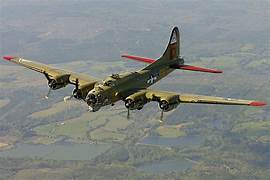On October 15, 1937, the United States witnessed a major milestone in aviation history with the introduction of the Boeing B-17 Flying Fortress. This iconic bomber aircraft played a critical role during World War II and became a symbol of American air power and technological prowess. The Boeing B-17 Flying Fortress was a four-engine heavy bomber designed to meet the United States Army Air Corps' stringent requirements for a long-range, high-altitude bomber capable of carrying a significant bomb load. The aircraft was named the "Flying Fortress" due to its heavily armed defensive capabilities, which included multiple machine guns positioned throughout the aircraft to fend off enemy attacks. The B-17 was a formidable aircraft, boasting a maximum speed of over 300 miles per hour and a range of more than 2,000 miles. Its ability to carry up to 8,000 pounds of bombs made it a formidable weapon in strategic bombing campaigns. The aircraft's design also incorporated advanced features such as a centralized fire control system, which allowed for synchronized firing of the defensive machine guns. The introduction of the B-17 Flying Fortress marked a significant advancement in bomber aircraft technology. It represented a shift towards larger, more heavily armed bombers capable of delivering devastating payloads to enemy targets. The aircraft's long-range capabilities made it ideal for conducting deep-penetration missions into enemy territory, enabling the United States to project its air power across vast distances. During World War II, the B-17 Flying Fortress played a crucial role in the Allied bombing campaign against Axis powers. It was extensively used in strategic bombing missions, targeting key industrial and military installations, as well as transportation infrastructure. The aircraft's ability to carry a substantial bomb load and its defensive armament made it a formidable adversary for enemy fighters and anti-aircraft defenses. The B-17 Flying Fortress quickly gained a reputation for its durability and survivability. Despite sustaining significant damage from enemy fire, the aircraft's rugged construction and self-sealing fuel tanks allowed it to continue flying and complete its mission. This resilience earned the aircraft the respect and admiration of its crews and the nickname "Flying Fortress." The B-17 Flying Fortress was not without its vulnerabilities, however. As the war progressed, the introduction of more advanced enemy fighters and improved anti-aircraft defenses posed significant threats to the aircraft. The B-17s often flew in formation to maximize their defensive firepower, but they still faced the risk of being shot down or sustaining heavy casualties. The B-17 Flying Fortress became an iconic symbol of American air power during World War II. Its distinctive silhouette, with its multiple gun turrets and sleek design, became instantly recognizable. The aircraft's contributions to the war effort and the bravery of its crews were widely celebrated, solidifying its place in aviation history. After the war, the B-17 Flying Fortress continued to serve in various roles, including reconnaissance, search and rescue, and air-sea rescue missions. However, with the advancement of jet-powered bombers, the B-17 gradually phased out of active military service. Today, a few B-17s still exist as flying museum exhibits, serving as a reminder of the aircraft's significant role in shaping the course of World War II. The introduction of the B-17 Flying Fortress on October 15, 1937, marked a pivotal moment in aviation history. Its advanced design, long-range capabilities, and formidable defensive armament made it a game-changer in strategic bombing missions during World War II. The aircraft's contributions to the war effort and its enduring legacy as an icon of American air power continue to be celebrated to this day.
15 Oct, 1937 U.S.A. The Flying Fortress
